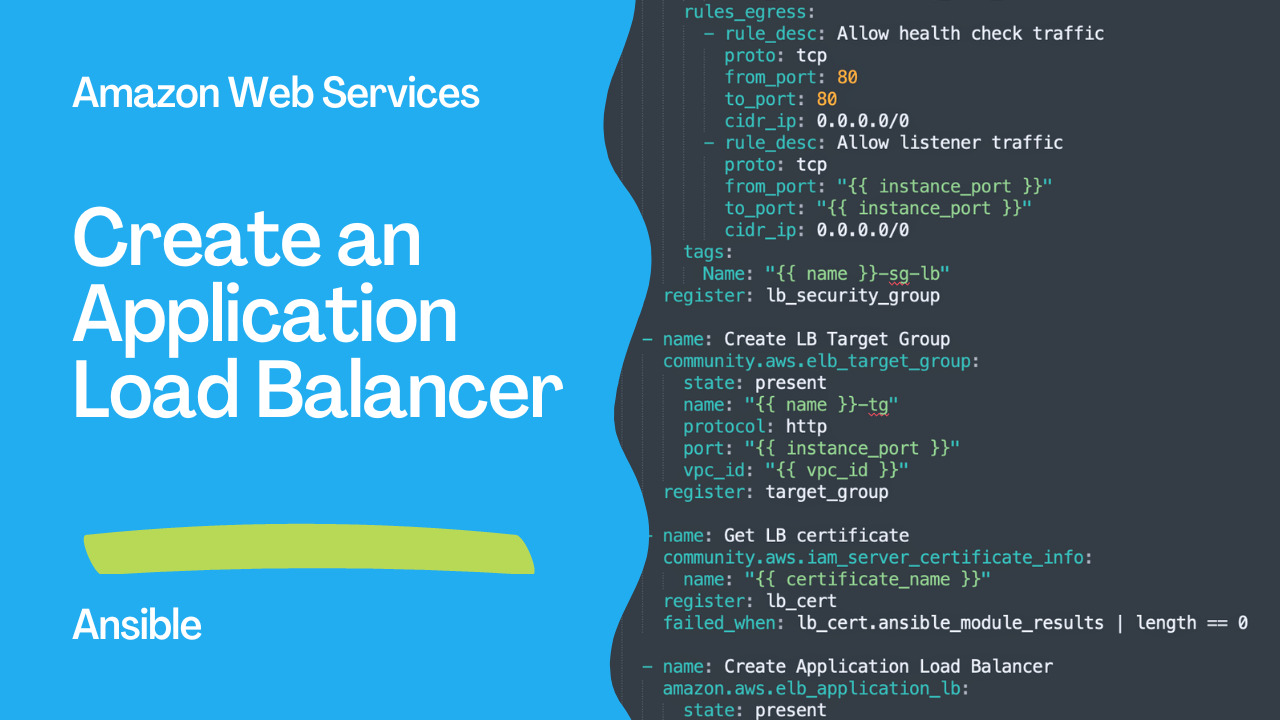Amazon Application Load Balancer (ALB)
As applications grow in complexity, they require more sophisticated infrastructure to ensure high availability and scalability. One of the key components of such infrastructure is a load balancer, which distributes traffic across multiple instances, improving application performance and reliability.
In Amazon Web Services (AWS), you can create an Application Load Balancer (ALB) to handle traffic distribution for your applications. And if you want to automate the creation of an ALB and its associated resources, you can use Ansible, a popular open-source automation tool.
In this article, we will guide you through the process of creating an ALB using Ansible in AWS.
Prerequisites
Before we dive into the Ansible playbook for creating an ALB, we need to set up a few things in AWS.
VPC and Subnets The first thing we need to do is to create a Virtual Private Cloud (VPC) and subnets where the ALB will be deployed. If you have not done this before, follow the instructions in the AWS documentation to create a new VPC and two subnets in different Availability Zones.
EC2 instances Next, we need to have at least two EC2 instances running in the subnets created above. These instances will serve as targets for the ALB. You can either create new instances or use existing ones.
IAM certificate Finally, we need to have an SSL/TLS certificate created in AWS Identity and Access Management (IAM) that we can use for HTTPS communication between the ALB and clients. Follow the instructions in the AWS documentation to create a new certificate.
Links

Demo
This Ansible playbook creates an application load balancer (ALB) in an Amazon Web Services (AWS) environment.
The playbook first creates a security group for the ALB, allowing inbound traffic on the specified listener port (HTTPS on port 443) and egress traffic for health checks and listener traffic.
Next, it creates a target group, which specifies the instances that will receive traffic from the ALB.
Then, it retrieves a certificate from AWS Identity and Access Management (IAM) for HTTPS communication between the client and the ALB.
Finally, it creates the ALB itself, specifying its name, scheme, access logging configuration, subnets, security groups, listeners, and SSL policy.
Overall, this playbook automates the process of creating an ALB and its associated resources in an AWS environment, which can be useful for automating deployment and scaling of applications.
---
- name: Create Aplication Load Balancer
hosts: all
vars:
name: server
region: eu-west-1
vpc_id: vpc-12345678
protocol: HTTPS
listener_port: 443
instance_port: 80
incoming_cidr_ip: 0.0.0.0/0
certificate_name: "certificate"
tasks:
- name: Create LB Security Group
amazon.aws.ec2_security_group:
state: present
name: "{{ name }}_lb_sg"
description: Security group for LB
region: "{{ region }}"
vpc_id: "{{ vpc_id }}"
purge_rules: yes
purge_tags: yes
rules:
- rule_desc: Allow inbound traffic
proto: tcp
from_port: "{{ listener_port }}"
to_port: "{{ listener_port }}"
cidr_ip: "{{ incoming_cidr_ip }}"
rules_egress:
- rule_desc: Allow health check traffic
proto: tcp
from_port: 80
to_port: 80
cidr_ip: 0.0.0.0/0
- rule_desc: Allow listener traffic
proto: tcp
from_port: "{{ instance_port }}"
to_port: "{{ instance_port }}"
cidr_ip: 0.0.0.0/0
tags:
Name: "{{ name }}-sg-lb"
register: lb_security_group
- name: Create LB Target Group
community.aws.elb_target_group:
state: present
name: "{{ name }}-tg"
protocol: http
port: "{{ instance_port }}"
vpc_id: "{{ vpc_id }}"
register: target_group
- name: Get LB certificate
community.aws.iam_server_certificate_info:
name: "{{ certificate_name }}"
register: lb_cert
failed_when: lb_cert.ansible_module_results | length == 0
- name: Create Application Load Balancer
amazon.aws.elb_application_lb:
state: present
name: "{{ name }}-lb"
scheme: internet-facing
access_logs_enabled: yes
access_logs_s3_bucket: "{{ s3_logging_bucket }}"
access_logs_s3_prefix: "ELBLogs"
subnets: "{{ subnets }}"
security_groups:
- "{{ lb_security_group.group_id }}"
purge_listeners: yes
listeners:
- Protocol: "{{ protocol }}"
Port: "{{ listener_port }}"
DefaultActions:
- Type: forward
TargetGroupName: "{{ target_group.target_group_name }}"
Certificates:
- CertificateArn: "{{ lb_cert.ansible_module_results[certificate_name]
.arn }}"
SslPolicy: ELBSecurityPolicy-TLS13-1-2-2021-06
Conclusion
This Ansible playbook creates an Application Load Balancer (ALB) in AWS. It first creates a security group for the ALB and defines inbound and outbound traffic rules. Then, it creates a target group for the ALB to direct traffic to. Next, it retrieves an SSL certificate for the ALB and finally creates the ALB, specifying the listeners and target group, along with the SSL certificate to be used for secure connections. This playbook is useful for automating the deployment of an ALB in an AWS infrastructure. Subscribe to the YouTube channel, Medium, and Website, X (formerly Twitter) to not miss the next episode of the Ansible Pilot.
Academy
Learn the Ansible automation technology with some real-life examples in my
Udemy 300+ Lessons Video Course.

My book Ansible By Examples: 200+ Automation Examples For Linux and Windows System Administrator and DevOps

Donate
Want to keep this project going? Please donate
